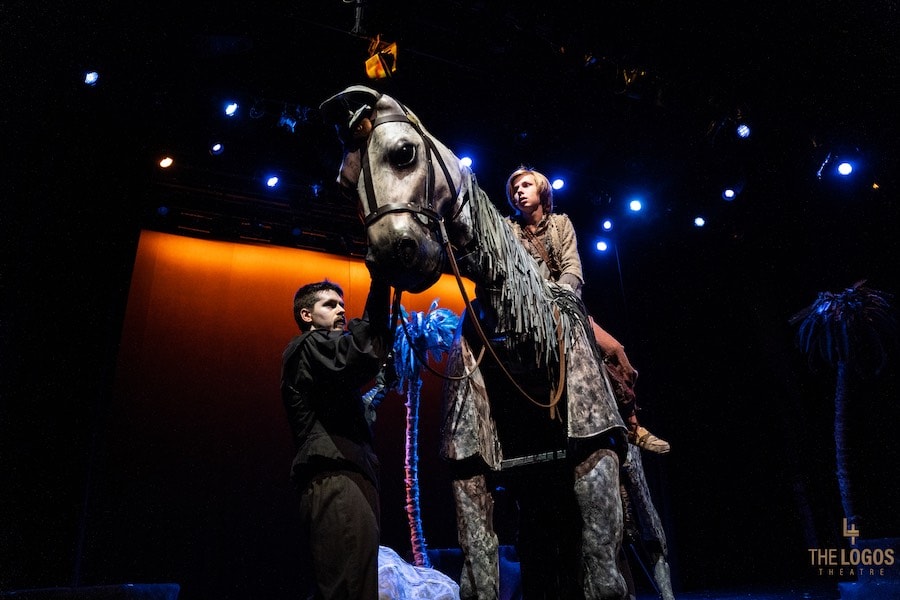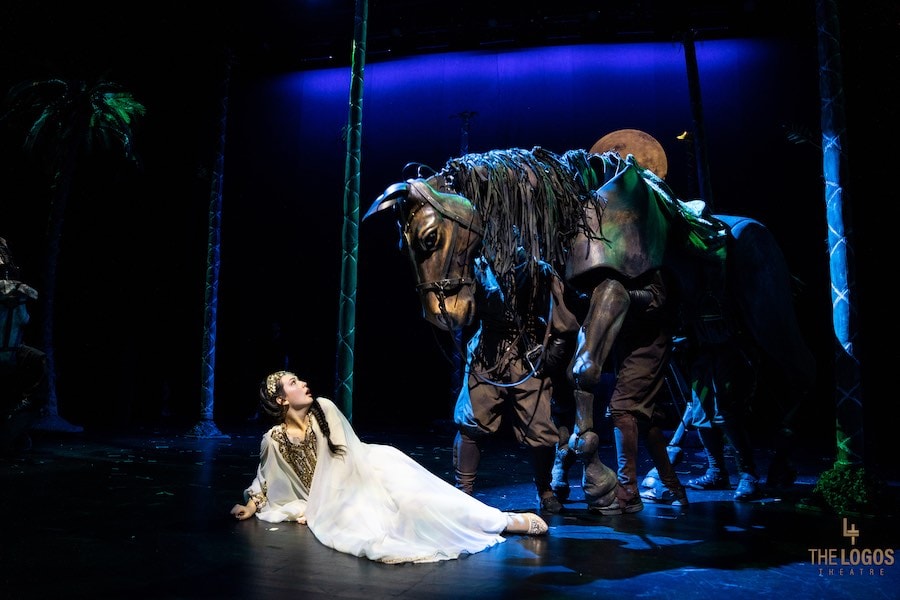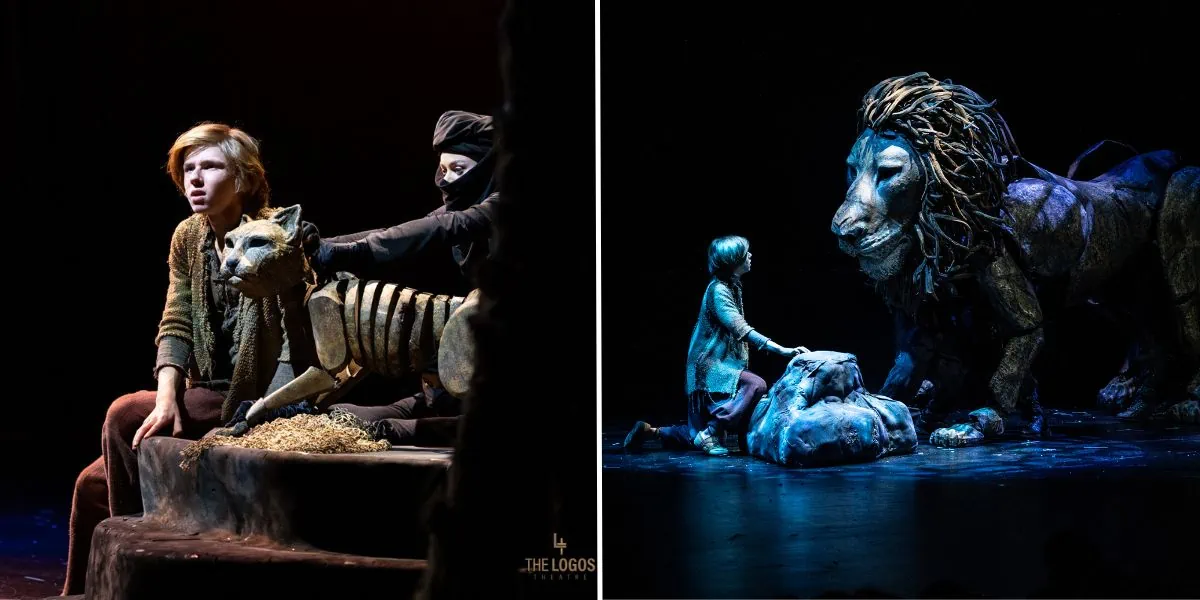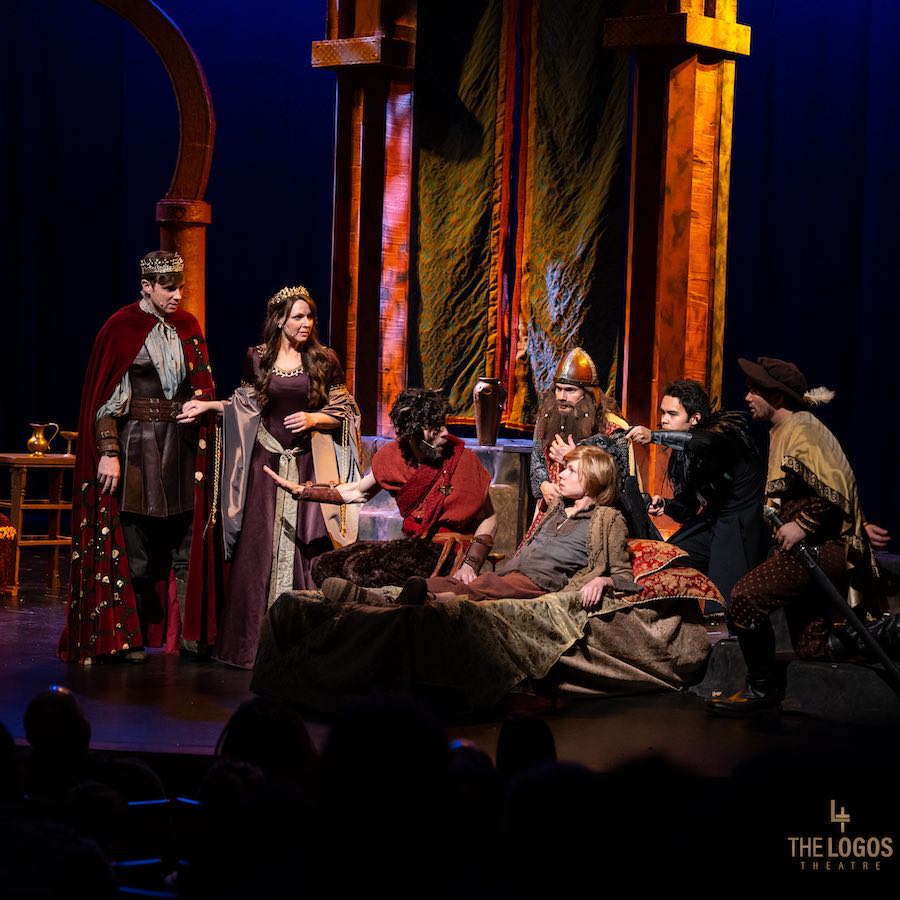(Originally published January 25, 2023)
There comes a heart-touching moment early in The Horse and His Boy when the two titular characters first meet and tell each other why they are desperate to escape. The boy has just learned that the fisherman whom he calls Father, who periodically beats him, intends to sell him into slavery to a nobleman chum. The horse, who talks, belongs to that very same nobleman and knows firsthand what an abusive master he is. After sharing their grim survivor stories, the boy and the horse decide on the spot to make their getaway together, to a utopian country in the north known as Narnia.

That exchange between horse and boy would alone propel a fantastical plot into motion, but here at the World Stage Theater inside the Museum of the Bible, in an epically spectacular production by Logos Theatre, there is something even more compelling going on. The boy, named Shasta, is played endearingly by towheaded, 13-year-old Brinton Stratton, and the talking horse, named Bree, voiced magnificently by Michael Hamilton, is played by a fully articulated lifesize puppet that seems to inhale and exhale as if alive. The nuzzling tenderness that the horse puppet shows the boy person is breathtaking. Their bonding binds us to them. The moment operates on a level of animate-inanimate emotional intimacy and theatricality that I have not seen onstage since the National Theatre production of War Horse at Lincoln Center.

Not long after, Shasta and Bree encounter a teenage noblewoman and another talking horse. The girl is named Aravis, played with feisty spunk by 15-year-old Liliana Groth. She too is desperate to escape and flee to Narnia, because her father, persuaded by her hateful stepmother, has arranged for her to marry an ugly old man whom she loathes. Disguised in her brother’s armor, she arrives riding Hwin, a massively graceful puppet mare voiced mellifluously by Sheri Chavers. Hwin too, it turns out, is fleeing a bad master. “To Narnia and the North!” Bree exclaims. And so, despite initial meet-cute animosity between the boy and the girl, all four strategize together (with literal horse sense) what they hope will be safe passage. (It won’t.)
The parallelism between the two kids’ awful fathering is striking. Add to that the equine enslavement and you’ve got a foursome of freedom-seekers whose fascinating interplay and adventures will weave in and out of a grand story arc about rescue and emancipation and captivate an audience of young and old alike along the way.
The same-titled fantasy novel upon which this play is based is by C.S. Lewis, one of seven in his series The Chronicles of Narnia, first published in the early 1950s. On stage as in the book, there is a lot of plot — somewhat more, perhaps, than can readily be followed by someone who has not read the book — and manifold character and place names. But the sharp script by Nicole Stratton is steadfastly respectful of the spirit of Lewis’ allegorical narrative, which he wrote as a children’s book to inspire faith and which lends itself wonderfully to stage adaptation. Plus the banter between the kids and the horses is priceless:
SHASTA: Did your horse just talk?
ARAVIS: What’s it got to do with you if she did?
SHASTA: Why, you’re only a girl!
ARAVIS: And what business is it of yours if I am only a girl? You’re probably only a boy. A slave probably, who’s stolen his master’s horse.
SHASTA: Shows how little you know!
BREE: He’s not a thief, little Tarkheena. At least, if there’s been any stealing, you might just as well say I stole him.
ARAVIS: Uhhh, Hwin, I wish you’d held your tongue. Now look at the trouble you’ve got us into.
SHASTA: Well, you can clear off as soon as you like. We shan’t keep you.
ARAVIS: No, you shan’t!
BREE: What quarrelsome creatures these humans are.
HWIN: Yes, they’re as bad as mules.
Playwright Stratton, who also directs this monumental staging (its cast numbers 45!), is the artistic director of the company that created it, Logos Theatre, based in Taylors, South Carolina. She took one liberty with the book and added a prologue because the plot turns in part on a twin-boys-separated-at-birth trope that might not be clear otherwise. In the play as in the story, it is revealed (semi-spoiler:) that Shasta has a twin brother who’s a crown prince (named Corin, played by a spit-and-image Easton Sewall). The prologue, which is the first scene theatergoers see, usefully dramatizes the backstory in which one of two royal sons is abducted from his bassinet — later to be set afloat in a boat upon a body of water where he, not unlike the infant Moses, is found by the aforementioned fisherman.
The large-scale production is complex but there are aspects that are particularly stunning. During scenes when the horses bearing Shasta and Aravis are galloping (pursued by evildoers), the illusion of speed and momentum under a full moon is achieved by black-cloaked actors racing across the stage with tall poles like palm trees passed in the night. Scene changes, of which there are many — from palaces to desert to tombs and more — are accomplished with vibrant lighting effects (designed by Hannah Hainsworth) and swiftly wheeled-in set pieces (designed and constructed by Joe Hainsworth). That there will be multiple such scene changes is evident from the start: I have never seen a stage so thoroughly spiked with tiny tape marks.
The cast wears a pageant’s worth of elegant and colorful costumes in period Persian storybook style (beautifully designed by Leah Udinski, who also plays vivaciously Lasaraleen, a young noblewoman and Aravis’ BFF). The uncredited, prerecorded music track under the storytelling meets each emotional beat of the script with the impact of a legendary film score. And as in blockbuster action movies, where the interpersonal scenes between the mayhem often mean most, the human and divine drama driving The Horse and His Boy is often most felt in the quieter moments — as when Shasta encounters a meowing, cuddling cat puppet.

That cute cat, we will learn, will become Aslan, a roaring, adult talking lion puppet who will play a profound role of protection and redemption in Shasta’s life. The scene where Aslan reveals to Shasta all the times and ways he saved Shasta from peril, unbeknownst to the boy, is among the most moving of the play:
SHASTA: I am the unluckiest person in the whole world.
ASLAN: I do not call you unfortunate.
SHASTA: Well, it was bad luck to meet so many lions anyway.
ASLAN: There was only one lion. But he was swift of foot.
SHASTA: How do you know?
ASLAN: I was the lion. I was the lion who forced you to join with Aravis. I was the cat who comforted you among the houses of the dead. I was the lion who drove the jackals from you while you slept. I was the lion who gave the horses the new strength of fear for the last mile, so that you should reach King Lune [Shasta’s real father] in time. And I was the lion you do not remember who pushed the boat in which you lay, a child.
The puppets and puppeteers in The Horse and His Boy merit their own ovation. Designed and built by puppet master Justin Swain, the creatures lend themselves to amazing expressivity when animated by the sensitive and skilled puppeteers inside and out. The horses have ears that wiggle with inflection, they wheeze and whinny with feeling, they clop and canter realistically, they seem to have inner lives.

The Horse and His Boy is a family show and at the performance I saw, the young ones’ attention appeared to be held all three hours by the fantastical story. The symbolism in the book may or may not read on stage as it does on the page. The theme of divine providence may or may not register. And for folks whose most frequented house of worship is a theater, that may not matter. There is plenty here to be wowed by.
Yet for those who, as is said, “have eyes to see and ears to hear,” there is also much to be stirred by — because only in live theater can one fully appreciate the beatific power and presence as when a puppet says to a person: “Beloved, let me breathe on you.”
Running Time: Approximately three hours, including a 15-minute intermission and a preshow promotion for presenting sponsor illumiNations Twelve Verse Challenge.
UPDATE: Back by popular demand, The Horse and His Boy returns from June 23 through August 6, 2023, presented by the Logos Theatre, in association with the C.S. Lewis Company Limited, performing at the World Stage Theater on the fifth and sixth floors of the Museum of the Bible, 400 4th Street SW, Washington, DC. Tickets ($54–$84) are available for purchase online. (All tickets purchased for opening weekend, June 23–25, receive 15% off with promo code OPENING.)
Shows run Thursday–Sunday from June 23–August 6 at 2:00 p.m. and 7:00 p.m. There will be two extra shows on Tuesday, July 4, 2023, at 10:30 a.m. and 3:00 p.m.
SEE ALSO:
Live theater returns to a gem of a venue at the Museum of the Bible (interview feature by John Stoltenberg, January 19, 2023)
PRINCIPAL CAST
SHASTA: Brinton Stratton
BREE (Voiced by Micah Hamilton)
ARAVIS: Liliana Groth
HWIN (Voiced by Sheri Chavers)
TARKAAN, KING EDMUND: Noah Stratton
QUEEN SUSAN: Nicole Stratton
QUEEN LUCY: Hope Barr
CORIN: Easton Sewell
LASARALEEN: Leah Udinski
ARSHEESH, MR. TUMNUS: Joseph Hainswort
KING LUNE: Joe Butler
RABADASH: Harrison Winkley
TISROC: Jonathan Barrows
HERMIT, KING PETER: Zac Johnson
PUPPETEERS
LOGOS PUPPET MASTER: Justin Swain
BREE PUPPETEERS: Justin Swain (Head), Daniel Hainsworth (Heart), Chandler Goodrich (Hind)
HWYN PUPPETEERS: Katrina McMinde (Head), Ronan Osteen (Heart), Ben Pilgrim (Hind)
ASLAN PUPPETEERS: Jeremy Singleton (Head), Jonathan Barrows (Heart), Isaac Schuyter (Hind)
CAT PUPPETEERS: Easton Sewall, Troy Barcus, Leah Barcus, Lauryn Wortham
WILD ASLAN PUPPETEERS: John Cassidy (Head), Caleb Mann/Jonah Elley-Lanik (Heart), Harrison Winkely (Hind)
SALLOWPAD: Sean Basto
ENSEMBLE CAST
ABIGAIL SUNDAHL: Queen Lune, Older Aravis, Calormen Woman
LYDIA MILLER: Stepmother, Calormen Woman, Soldier
SAVANNAH ANDERSON: Nasira, Leopard, Calormen Woman
JONATHAN BARROWS: also Soldier, the Watch
JOSEPH HAINSWORTH: also Narnian Soldier
NOAH STRATTON: also Father of Aravis
EASTON SEWALL: also Corin
JUSTIN SWAIN: also Lord Barr
JOE BUTLER: also Groomsman, the Watch, Litter Bearer
DANIEL HAINSWORTH: also Soldier
LEAH UDINSKI: also Nurse
JENN JAMES: Calormen Woman, Hedgehog
JENN SWAIN: Bricklethumb
BRANSEN/ELIAS SWAIN: Dwarf Children, Mice
SEAN BASTO: Sage, Soldier, Litter Bearer
JEREMY SINGLETON: also Lord Peridan/Soldier
CALEB SMEDRA: Soldier, Older Cor
JOHN CASSIDY: also Soldier
BEN PILGRIM: also Soldier
HOPE BARR: also Servant
RONAN OSTEEN: also Soldier
ISAAC SCHUYLER: also Soldier, Dwarf 1
CHANDLER GOODRICH: also Soldier
LAURYN WORTHAM: also Soldier, Catormen Woman
RACHEL SORGIUS: Calormen Woman, Soldier
CALEB MANN: also Soldier, Crier
LAELGOODRICH: Amaya, Calormen Woman, Soldier
JONAH ELLEY-LANIK: also Shasta double, Soldier
JONATHAN OVERSTREET: also Duffle, Soldier, Donkey Rabadash
LEAH BARCUS: also Calormen Woman, Rabbit
BROOKE HERNANDEZ: Older Aravis, Calormen Woman, Soldier
LEWIS BLISS: Damn, Soldier
ASA GUECK: Corrin understudy
ANN INGRAHAM: Calormen Woman
MICHAEL INGRAHAM: Vizier, Soldier, Utter Bearer
ADDISON RANDAZZO: Rogin, Soldier
CREW ACKNOWLEDGEMENTS
WRITER AND DIRECTOR: Nicole Chavers Stratton
PRODUCER: Noah Stratton
PUPPET MASTER: Justin Swain
SET DESIGN AND CONSTRUCTION: Joe Hainsworth
LIGHTING DESIGN: Hannah Hainsworth
COSTUMES: Leah Udinski
PROPS: Kayla Goodfellow, Justin Swain
MICROPHONES: Mariah Hainsworth
SOUND OPERATOR: Laura Warren
SOUND ENGINEER: Olivia Singleton
PUPPET VOICE OPERATOR: Abigail Pierce
WIGS, HAIR, AND MAKEUP ARTIST: Rachel Maciejack
ASSISTANT TO MAKEUP: Rachel Sorgius
MEDIA TECHNICIAN: Jennifer James
MARKETING AND PROMOTIONS LIAISON: Jennifer Swain
GRAPHICS: Jeremiah Gould, Liz Preston




